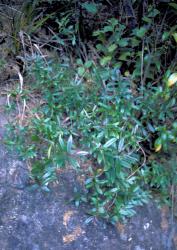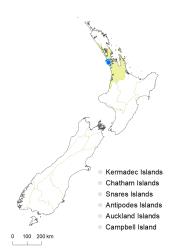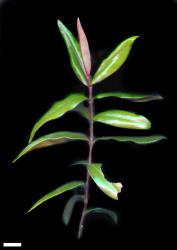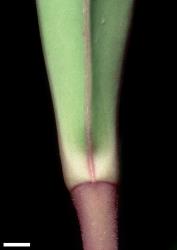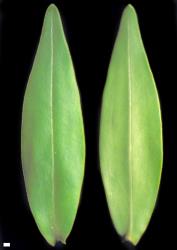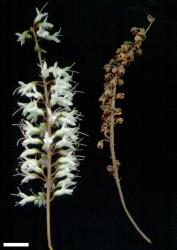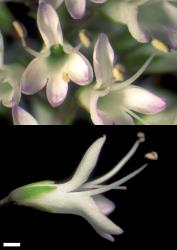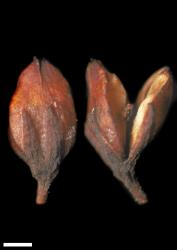- ≡ Hebe bishopiana (Petrie) Hatch, Newslett. Auckland Bot. Soc. 23: 1 (1966)
Spreading low or bushy shrub to 1 m tall. Stems sprawling to ascending; glabrous or minutely eglandular-puberulent; hairs bifarious or uniform. Leaf bud distinct, its leaves appressed at margins until fully grown; sinus absent. Leaves opposite-decussate, erecto-patent to recurved; lamina sub-coriaceous, lanceolate to narrow-elliptic or oblanceolate, 20–90 mm long, 8–22 mm wide, glossy dark green above, tinged maroon, especially on midrib, maroon or pinkish beneath, sometimes pale green; midrib evident; surfaces usually with eglandular hairs along midrib above, sometimes glabrous; margin ciliolate, entire; apex acute to weakly acuminate; base cuneate; petiole absent. Inflorescence a lateral raceme, 50–170 mm long; flowers crowded, 70–170, all bisexual; bracts alternate or loosely whorled, linear-lanceolate to elliptic, < to > pedicels; pedicels erecto-patent to spreading, recurved at fruiting, 1.5–4.0 mm long, eglandular-pubescent all around. Calyx lobes 4 (rarely a small 5th posterior lobe present), sub-acute to acuminate, 1.7–2.5 mm long, equal or sub-equal, mixed glandular- and eglandular-ciliolate, usually pubescent or sometimes glabrous outside. Corolla 4.5–6 mm diameter; tube white, 2–4 mm long, ≥ calyx, eglandular-hairy inside and sometimes outside; lobes 4, white or tinged pale purplish, erecto-patent to spreading, sub-equal, 2–4 mm long, obtuse to rounded; nectar guides absent. Stamen filaments white or pale purplish, 5.5–8.0 mm long; anthers purplish or buff. Style glabrous or sparsely hairy, 6–8 mm long. Capsules latiseptate, sub-acute, glabrous or eglandular-hairy, 3.0–4.5 mm long, 2.4–3.0 mm at widest point.. Seeds discoid to broadly ellipsoid, flattened, smooth, pale brown, 0.6–0.8 mm long.
V. bishopiana plants are similar to V. obtusata, but plants of the latter can be distinguished by their thicker and broader leaves, which have longer cilia on the margins and taper abruptly to an obtuse apex, their shorter pedicels, blunter calyx lobes fringed with eglandular hairs and only a few glandular ones, but glabrous on the outer surfaces, broader and more pointed corolla lobes, and more acute capsules, which are nearly always glabrous, and larger seeds.
V. bishopiana plants may resemble V. stricta, which can be distinguished by a more open and spreading habit, green young stems, brighter green leaves only rarely red underneath, and hairier calyces. Plants of V. ligustrifolia, V. rivalis and V. flavida can be distinguished by their green stems and leaves, corolla tube ≤ calyx, and acute corolla lobes; in addition V. flavida leaves are often larger (30–135 × 6–29 mm) and have a distinctive yellowish base to the midrib. V. ligustrifolia, V. rivalis and V. flavida do not occur in the Waitākere Ranges.
North Island: Auckland (Waitākere Ranges).
Stream-sides, shaded cliff faces, seepages on exposed outcrops, track margins in low scrub. Recorded elevations range from 60 to 390 m.
Flowers: October–July (mostly between February and June); fruits: May–August (persisting until November).
2n = 40 (see Bayly & Kellow 2006, as Hebe bishopiana).
Veronica bishopiana is classified in V. subg. Pseudoveronica sect. Hebe and the informal group “Occlusae” (Albach & Meudt 2010; Bayly & Kellow 2006).
V. bishopiana appears intermediate between V. obtusata and V. stricta, and was at first thought to be a hybrid between them. It may be that it has originated from such a cross, but it now appears to be locally stable and true-breeding and probably represents a diploid hybrid species. This question is discussed more fully by de Lange (1996) and by Bayly & Kellow (2006).



